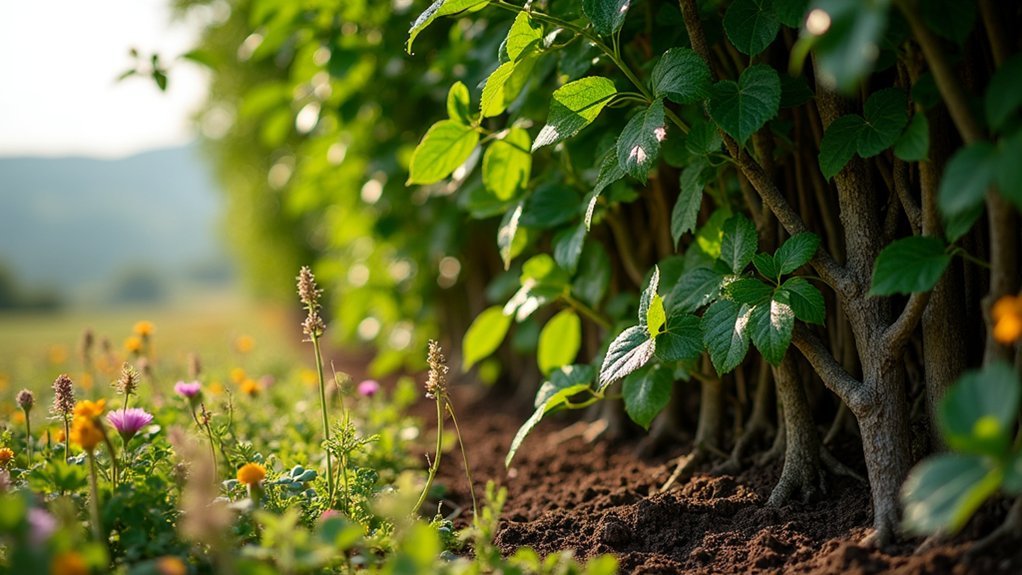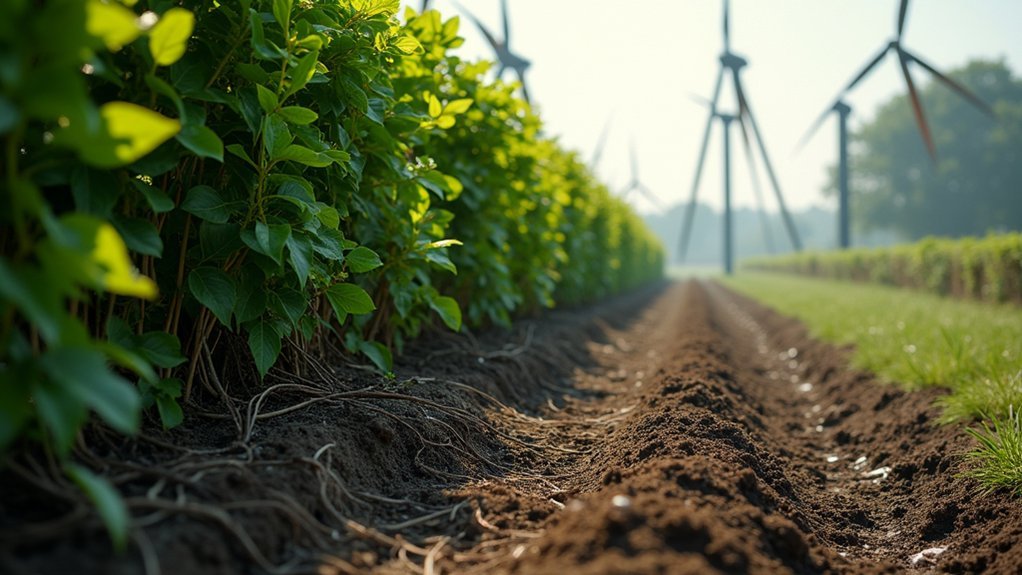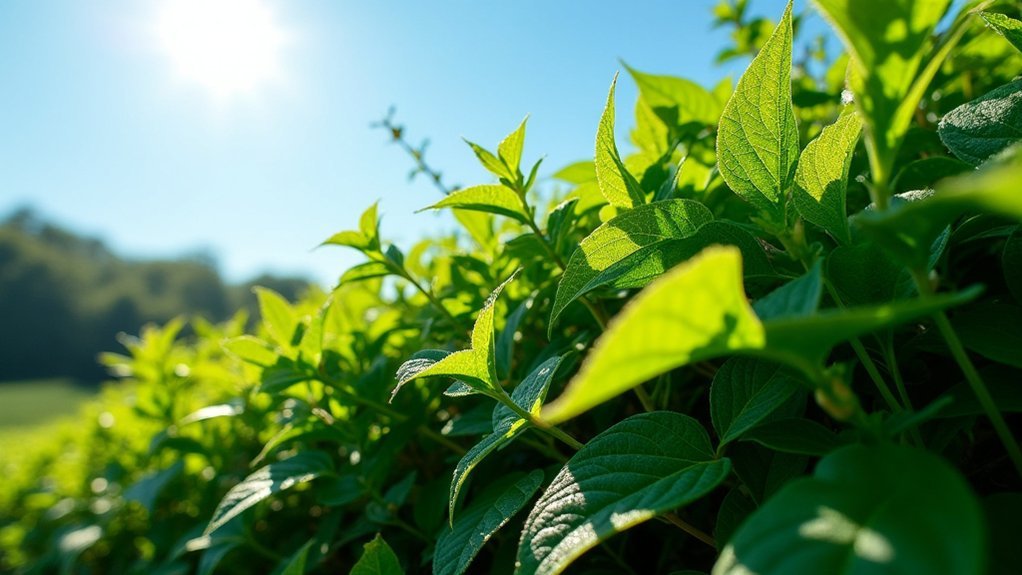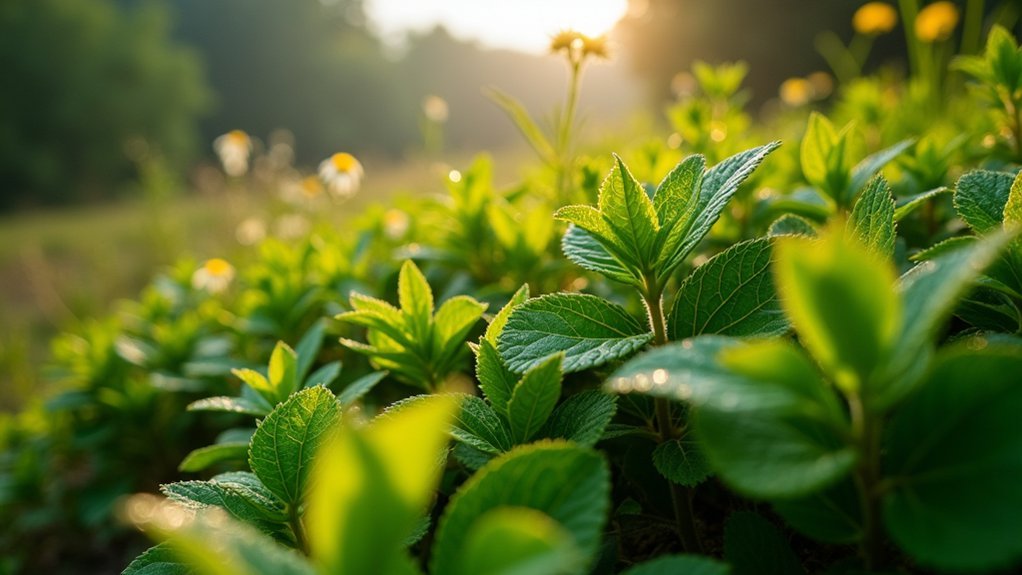Regenerative hedges survive climate shifts through their deep root systems that access water below topsoil during droughts. You’ll find that diverse native species improve resilience, as some plants thrive when others struggle. These hedges reduce wind speed by up to 50%, retain soil moisture, and create protective microclimates that buffer temperature fluctuations by 1-2°C. Their polyculture design also cuts pest outbreaks by half compared to monocultures. The secrets to their remarkable adaptability lie in their layered complexity.
The Deep-Root Advantage of Climate-Resilient Hedges

While surface-level vegetation struggles during prolonged drought periods, deep-rooted hedgerows thrive by tapping into water resources far below the topsoil.
You’ll find these resilient plants accessing nutrients from deeper soil layers, giving them a significant advantage when climate shifts bring extended dry spells.
These extensive root systems deliver benefits beyond survival. They transform soil structure and enhance carbon sequestration, storing up to 31% more carbon than adjacent grasslands.
Deep-rooted hedgerows don’t just survive—they revolutionize landscapes by locking away carbon at rates that far outpace surrounding environments.
Species like oak and hazel demonstrate remarkable adaptability to fluctuating climate conditions.
The impressive underground networks of climate-resilient hedges also support essential microbial communities that boost soil health.
As climate change intensifies erosion and soil degradation, these deep-rooted hedgerows provide critical protection, maintaining ecosystem balance while ensuring their own sustainability for decades to come.
Soil Moisture Retention Through Diverse Hedge Systems
Nature’s sponges, diverse hedge systems dramatically improve soil moisture retention through their complex structure and varied composition.
You’ll find these living barriers can boost moisture retention by up to 31% compared to surrounding grasslands, making them invaluable for climate resilience.
When you plant hedgerows with both deep and shallow-rooted species, you’re creating a multi-layered moisture-capturing system that reduces evaporation during dry spells.
They’ll meaningfully decrease wind speed, preventing rapid soil drying while improving water infiltration.
The diverse root networks in your hedges don’t just hold water—they enhance soil structure and increase organic matter content.
This promotes beneficial microbial activity and soil aggregation, further improving your land’s water-holding capacity.
As climate shifts intensify, these living water reservoirs become increasingly critical to agricultural sustainability.
Carbon Sequestration Benefits of Living Boundaries

As climate concerns intensify, regenerative hedges stand out as powerful carbon sinks in agricultural landscapes. You’ll find these living boundaries can store up to 31% more carbon than adjacent grasslands, making them crucial components of regenerative agriculture practices.
Consider these impressive carbon sequestration benefits:
- Hedgerows capture approximately 1.48 Mg carbon per hectare annually, considerably enhancing your farm’s carbon storage capacity.
- Mature 37-year-old hedges store around 40 Mg carbon per hectare, proving age enhances effectiveness.
- Expanding hedgerow coverage by 40% could sequester 6.3 Tg of CO2 over four decades.
- Combined private-public initiatives are essential, as government funding alone falls short for meeting carbon targets.
Weather-Resistant Species Selection for Hedge Plantings
You’ll greatly improve your hedge’s climate resilience by selecting native, drought-tolerant species that have evolved to thrive in your local conditions.
When planning your hedgerow, consider incorporating a diverse mix of deep-rooted plants that can withstand variable weather patterns while requiring minimal irrigation.
These multi-zone adaptable species not only survive climate shifts but also provide essential habitat and food sources for wildlife throughout changing seasons.
Drought-Tolerant Native Plants
While climate shifts intensify droughts across many regions, selecting the right native plants for your hedgerows becomes increasingly essential. Drought-tolerant native species like lavender and yarrow have adapted to local conditions, requiring notably less water while enhancing soil health.
When planning your climate-resilient hedgerow, consider these advantages:
- Native plants develop deeper root systems, accessing moisture from lower soil layers during dry periods.
- Diverse native hedgerows store 31% more carbon compared to conventional grasslands, boosting carbon sequestration.
- Local species like oak and elderberry survive extended dry periods without irrigation.
- Biodiversity in your hedgerow improves water retention and overall resilience to climate stressors.
Multi-Zone Adaptable Species
Beyond drought-tolerant natives, selecting multi-zone adaptable species creates truly resilient hedgerows capable of withstanding our increasingly unpredictable climate patterns.
You’ll find that weather-resistant plants like hawthorn and blackthorn excel during extreme conditions, maximizing their carbon sequestration potential even as temperatures fluctuate.
Research confirms that diverse hedgerows demonstrate superior resilience.
When you incorporate species with deep root systems, such as willows, you’re improving soil stability and water retention—critical factors during climate shifts.
For best results, prioritize local and indigenous flora in your design.
These plants have already adapted to your region’s specific conditions, enhancing biodiversity while ensuring better survival rates.
Biodiversity Corridors: How Varied Hedge Structures Thrive

As climate patterns shift unpredictably, varied hedge structures emerge as essential biodiversity corridors that connect fragmented landscapes.
You’ll find these living networks serve multiple functions beyond their aesthetic appeal.
Diverse hedgerows enhance your land’s resilience through:
- Improved biodiversity – Multiple plant species create habitats supporting wildlife that can adapt to changing conditions.
- Enhanced carbon storage – Complex hedgerows store up to 57.2% more soil carbon than younger, simpler ones.
- Better soil fertility – Mixed native vegetation improves nutrient cycling, making your land more drought and flood resistant.
- Wildlife migration pathways – Connected hedges allow species to shift their ranges as climate zones change.
Temperature Regulation Properties of Layered Hedge Design
You’ll find that layered hedges create protective microclimates by stacking diverse plant species at varying heights, which can buffer temperature fluctuations by 1-2 degrees Celsius during extreme heat events.
These natural structures reduce wind speed and create sheltered pockets, maintaining more stable temperatures for both the hedge plants themselves and surrounding garden areas.
The dense vegetation network also improves soil moisture retention, ensuring root zones remain at consistent temperatures even as climate patterns shift unpredictably.
Microclimate Creation Mechanisms
While modern climate engineering often relies on expensive technologies, layered hedge designs offer a natural alternative for temperature regulation.
When you establish these living structures, you’re creating powerful microclimates that protect against temperature extremes while promoting biodiversity.
The mechanisms behind this remarkable climate control include:
- Wind speed reduction – Hedgerows can decrease wind velocity by up to 50%, minimizing soil moisture loss.
- Optimized light capture – Varied structure enhances photosynthesis in lower layers, strengthening the plant community.
- Shade provision – Dense foliage lowers soil temperatures and protects sensitive understory vegetation.
- Moisture retention – The combined canopy creates humidity zones that maintain stable conditions during climate shifts.
These natural mechanisms work together to form resilient ecological pockets that support plant and animal adaptation without requiring high-tech intervention.
Wind-Buffer Thermal Effects
The thermal properties of layered hedge systems extend far beyond simple wind barriers. When you create a layered hedge, you’re establishing a sophisticated temperature regulation system that can reduce wind speed by up to 50%, protecting vulnerable plants within your garden ecosystem.
These wind-buffer effects create pockets of stable microclimate where temperature fluctuations are minimized. During cold snaps, your layered hedges trap heat; during heatwaves, they maintain moisture and coolness. This stability is critical for plant survival as climate patterns become less predictable.
The structural complexity of mixed-height plantings improves soil health through diverse rooting depths, enhancing carbon sequestration while stabilizing the entire ecosystem.
Root-Zone Temperature Stability
Beneath the visible canopy of your layered hedge system lies perhaps its most critical climate-resilience feature: root-zone temperature stability.
When you incorporate diverse plant species with varying root depths, you’re creating a living temperature regulation system that can reduce soil temperature fluctuations by up to 50%.
Your layered hedge maintains stable root-zone temperatures through:
- Deeper-rooted species accessing cooler subsoil temperatures, buffering against surface extremes
- Organic leaf litter forming natural thermal insulation around critical root zones
- Diverse root structures improving soil structure and moisture retention
- Stabilized soil moisture levels keeping roots cooler during droughts and warmer during cold spells
This temperature stability creates a protective microclimate below ground, allowing your hedge plants to thrive despite increasingly unpredictable climate patterns above.
Drought Tolerance Mechanisms in Regenerative Hedgerows
As climate patterns become increasingly unpredictable, regenerative hedgerows offer remarkable drought resilience through multiple adaptive mechanisms. Their deep root systems access moisture from lower soil profiles when surface layers dry out, maintaining vigor during extended dry periods.
You’ll find these hedgerows particularly effective at building soil organic carbon, which acts like a sponge to retain water. This enhancement of soil structure is a cornerstone of regenerative agricultural practices that build long-term drought resilience.
The diversity within well-designed hedgerows provides natural insurance—when some species struggle, others thrive. Native plants perform exceptionally well, having evolved alongside local climate fluctuations.
Strategic coppicing further strengthens drought tolerance by encouraging vigorous new growth and efficient photosynthesis, even when water becomes scarce.
Wind-Break Engineering: Structural Elements for Stability

You’ll find that effective wind-break engineering hinges on achieving the right density-height ratio in your hedgerows, with taller, moderately dense structures typically outperforming shorter, impenetrable ones.
Your hedgerow’s root architecture system plays a vital role in stability, where deep taproots combined with spreading lateral roots create anchoring networks that withstand intense wind events.
When you’re designing these living barriers, remember that structural elements like canopy density and branch flexibility work together to disperse wind energy rather than merely blocking it.
Wind-Break Engineering: Structural Elements for Stability
When implemented strategically, hedgerows serve as powerful structural elements in wind-break engineering, substantially reducing wind velocity by 30-50% at ground level.
You’ll find this protection critical for maintaining crop stability despite increasing climate variability.
For ideal wind-break design, consider these key factors:
- Maintain a height-to-width ratio of 1:10—a 10-meter wide hedgerow should be about 1 meter tall
- Select diverse plant species to enhance resilience against pests and diseases
- Incorporate deep-rooted species to improve soil structure and prevent wind damage
- Position hedgerows perpendicular to prevailing winds to maximize soil erosion protection
These structural elements create microclimates that reduce water loss and protect vulnerable crops, ultimately providing long-term stability for your agricultural ecosystem as climate patterns become less predictable.
Density-Height Ratio Balance
The density-height ratio balance forms the cornerstone of effective wind-break engineering, challenging the previously mentioned 1:10 height-to-width guideline. Current research shows that a 1:5 ratio enhances both wind protection and light penetration for adjacent crops.
When you’re designing your hedgerows, remember that proper density-height ratio management can reduce wind velocity by up to 50%, protecting your soil from erosion and moisture loss.
You’ll want to incorporate taller trees for maximum wind resistance while maintaining denser shrubs at the base for enhanced soil protection.
This balanced approach doesn’t just strengthen your hedge against climate shifts—it also maximizes carbon sequestration potential through healthy biomass maintenance.
Root Architecture Systems
Root architecture forms the hidden foundation of effective wind-break engineering, extending the benefits of proper density-height ratios below ground. Your hedge’s survival during climate shifts depends largely on what you can’t see—extensive root systems that anchor plants firmly against extreme weather.
To maximize your hedge’s climate resilience:
- Encourage deep taproot development to enhance stability during high winds.
- Support fibrous root growth for improved soil structure and moisture retention.
- Plant species with aggressive root systems that withstand erosion and anchor soil effectively.
- Consider soil carbon sequestration potential—hedges with ideal root architecture sequester 31% more carbon.
These underground networks don’t just stabilize your hedgerow; they’re working to improve soil health and contribute to the ecosystem’s overall ability to withstand changing conditions.
Your regenerative hedge’s strength begins beneath the surface.
Pest and Disease Resistance in Polyculture Hedges

While traditional agricultural systems often struggle with persistent pest problems, polyculture hedges offer a remarkable solution through their natural pest and disease resistance mechanisms.
You’ll find these diverse hedgerows can reduce pest outbreaks by up to 50% compared to monoculture systems, enhancing your farm’s resilience against climate shifts.
The secret lies in biodiversity—multiple plant species disrupt pest life cycles and attract beneficial insects that naturally control unwanted populations.
These predators and parasitoids become your allies, greatly reducing the need for chemical interventions.
Beyond what’s visible above ground, diverse root systems improve soil health and microbiome diversity, boosting plant vigor through enhanced nutrient uptake.
Some plants even produce allelopathic compounds that naturally deter pests and pathogens, creating a self-regulating ecosystem that’s prepared to withstand changing climate conditions.
Seasonal Adaptations of Multi-Species Boundary Systems
As seasons shift between extremes, multi-species boundary systems demonstrate remarkable adaptability that single-crop approaches simply can’t match.
You’ll find these hedgerows enhance your land’s resilience through their seasonal adaptations and biodiversity support.
When you establish diverse hedgerows, you’re creating a climate-resilient system that:
- Creates protective microclimates that buffer temperature fluctuations year-round
- Utilizes varied root systems that improve soil structure and moisture retention across seasons
- Stores 31% more carbon sequestration potential compared to adjacent grasslands
- Leverages native species that naturally adapt to local seasonal patterns and weather extremes
These adaptations mean your hedgerows don’t just survive climate shifts—they thrive through them, providing ecosystem stability while continuously capturing carbon regardless of seasonal challenges.
Water Cycling Enhancement Through Hedge Management
Since proper water management remains essential in our changing climate, strategic hedge design offers powerful solutions for optimizing water cycles on your land. You’ll find that diverse, native hedgerows greatly improve soil moisture retention by up to 50%, providing vital support for crops during dry spells.
When you implement coppicing techniques, you’ll encourage new growth that increases canopy cover, reducing evaporation and making water usage more efficient. The extensive root systems of your hedgerows will improve soil structure, enhancing water infiltration.
| Hedge Practice | Water Cycling Benefit | Implementation |
|---|---|---|
| Diverse species | Improved soil moisture | Plant 3+ native species |
| Coppicing | Reduced evaporation | Cut select stems every 5-7 years |
| Native vegetation | Enhanced groundwater recharge | Replace invasives with locals |
Long-Term Climate Resilience: Succession Planning for Hedgerows
Because climate patterns continue to shift unpredictably, your hedgerow design must incorporate succession planning for lasting resilience.
As climate chaos reshapes our world, future-proofed hedgerow designs ensure ecological stability across generations.
Mature hedgerows over 37 years old sequester up to 57.2% more carbon than younger ones, emphasizing the importance of long-term planning.
To maximize climate resilience and carbon sequestration in your hedgerows:
- Select diverse native species adapted to your local conditions that can withstand climate variability
- Implement regular coppicing to rejuvenate growth and extend hedgerow lifespan
- Prioritize biodiversity with varying root systems and leaf types to enhance soil carbon levels
- Allow natural maturation processes—older hedges contribute considerably more to ecosystem health
Frequently Asked Questions
How Does Regenerative Farming Reduce Climate Change?
You’ll reduce climate change through regenerative farming by enhancing soil health, which sequesters carbon, improves crop yields, and fosters biodiversity. Your practices like cover cropping and reduced tillage actively remove CO2 from the atmosphere.
What Plants Are Resilient to Climate Change?
You’ll find native perennials, drought-tolerant species like succulents and certain grasses, and trees such as willow and alder are highly resilient to climate change due to their established root systems and adaptive capabilities.
Why Are Farmers Against Regenerative Farming?
You’re hesitant about regenerative farming due to high shift costs, unpredictable yields, delayed financial returns, steep learning curves, and market structures that favor conventional methods. It’s not opposition, but practical concerns about implementation.
What Are the Four Characteristics of Regenerative Agriculture?
You’ll find four key characteristics of regenerative agriculture: soil health restoration through minimal tillage, carbon sequestration via organic practices, biodiversity enhancement through crop diversity, and ecosystem resilience that supports long-term sustainability.
In Summary
Your climate-resilient hedge isn’t just a boundary—it’s a living ecosystem that adapts to changing conditions. By selecting diverse species with deep root systems, you’re creating a carbon sink that retains moisture and supports biodiversity. You’ll find that proper management enhances water cycling while building natural resistance to pests and extreme weather. Plan for succession, and your hedgerow will continue to thrive despite climate uncertainties.





Leave a Reply